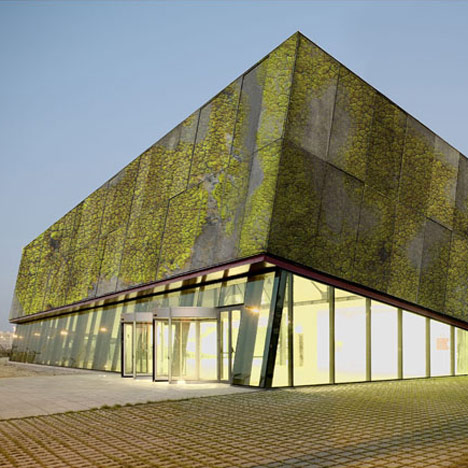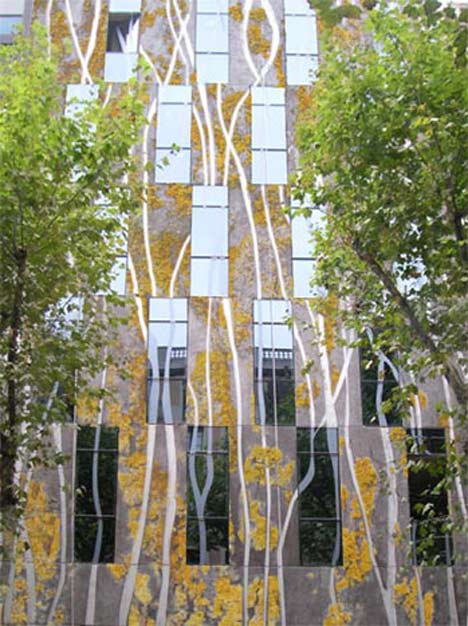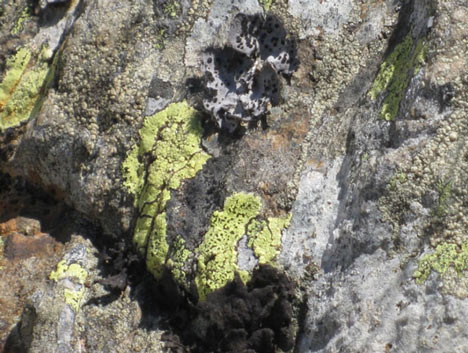
Researchers develop "biological concrete" for moss-covered walls
News: Scientists at a Spanish university are developing a new type of concrete that captures rainwater to create living walls of moss and fungi.
Unlike existing vertical garden systems which require complex supporting structures, the new "biological concrete" supports the growth of organisms on its own surface, according to researchers from Universitat Politècnica de Catalunya in Barcelona.

Top image: simulation of a vegetated facade at the Aeronautical Cultural Centre in El Prat de Llobregat
Above: simulation of a vegetated facade at the Ako-Suites Aparthotel in Barcelona
The concrete contains a biological layer that collects and stores rainwater, providing a moist growing environment where microalgae, fungi, lichens and mosses can thrive, they explain in a report.
A waterproof layer separates the organisms from the inner structural part of the concrete, while an outer layer acts in reverse, allowing rainwater in and preventing it from escaping.

Above: lichens on a rock
The concrete also absorbs carbon dioxide in the atmosphere and acts as an insulating material and a thermal regulator, say the researchers, who are currently in the process of patenting the material.
The next step is to accelerate the process so that the mossy surface develops in under a year, they add.
We've featured lots of buildings with living walls, including a mossy office building in Amiens, France, and a São Paulo furniture showroom covered with plant-filled vases – see all our stories about green walls.
We've also featured a number of projects using algae, such as a conceptual skyscraper that would make energy from algae and a concept car that would also use the organism to make fuel – see all our stories about algae.
Images are courtesy of UPC.
Here's some more information from the researchers:
Researchers at the UPC develop a biological concrete for constructing “living” façades with lichens, mosses and other microorganisms
The Structural Technology Group has developed and patented a type of biological concrete that supports the natural, accelerated growth of pigmented organisms. The material, which has been designed for the façades of buildings or other constructions in Mediterranean climates, offers environmental, thermal and aesthetic advantages over other similar construction solutions.
In studying this concrete, the researchers at the Structural Technology Group of the Universitat Politècnica de Catalunya · BarcelonaTech (UPC) have focused on two cement-based materials. The first of these is conventional carbonated concrete (based on Portland cement), with which they can obtain a material with a pH of around 8. The second material is manufactured with a magnesium phosphate cement (MPC), a hydraulic conglomerate that does not require any treatment to reduce its pH, since it is slightly acidic.
On account of its quick setting properties, magnesium phosphate cement has been used in the past as a repair material. It has also been employed as a biocement in the field of medicine and dentistry, indicating that it does not have an additional environmental impact.
The innovative feature of this new (vertical multilayer) concrete is that it acts as a natural biological support for the growth and development of certain biological organisms, to be specific, certain families of microalgae, fungi, lichens and mosses.
Having patented the idea, the team is investigating the best way to promote the accelerated growth of these types of organisms on the concrete. The goal of the research is to succeed in accelerating the natural colonisation process so that the surface acquires an attractive appearance in less than a year. A further aim is that the appearance of the façades constructed with the new material should evolve over time, showing changes of colour according to the time of year and the predominant families of organisms. On these kinds of buildings, other types of vegetation are prevented from appearing, lest their roots damage construction elements.
Three layers of material
In order to obtain the biological concrete, besides the pH, other parameters that influence the bioreceptivity of the material have been modified, such as porosity and surface roughness. The result obtained is a multilayer element in the form of a panel which, in addition to a structural layer, consists of three other layers: the first of these is a waterproofing layer situated on top of the structural layer, protecting the latter from possible damage caused by water seeping through.
The next layer is the biological layer, which supports colonisation and allows water to accumulate inside it. It acts as an internal microstructure, aiding retention and expelling moisture; since it has the capacity to capture and store rainwater, this layer facilitates the development of biological organisms.
The final layer is a discontinuous coating layer with a reverse waterproofing function. This layer permits the entry of rainwater and prevents it from escaping; in this way, the outflow of water is redirected to where it is aimed to obtain biological growth.
CO2 reduction
The new material, which has various applications, offers environmental, thermal and aesthetic advantages, according to the research team led by Antonio Aguado and supported by Ignacio Segura and Sandra Manso. From an environmental perspective, the new concrete absorbs and therefore reduces atmospheric CO2, thanks to its biological coating.
At the same time, it has the capacity to capture solar radiation, making it possible to regulate thermal conductivity inside the buildings depending on the temperature reached. The biological concrete acts not only as an insulating material and a thermal regulator, but also as an ornamental alternative, since it can be used to decorate the façade of buildings or the surface of constructions with different finishes and shades of colour; it has been designed for the colonisation of certain areas with a variety of colours, without the need to cover an entire surface. The idea is to create a patina in the form of a biological covering or a “living” painting.
There are also possibilities for its use in garden areas as a decorative element and as a sustainable means of blending buildings and constructions into the landscape.
Architectural renovation
The material lends itself to a new concept of vertical garden, not only for newly built constructions, but also for the renovation of existing buildings. Unlike the current vegetated façade and vertical garden systems, the new material supports biological growth on its own surface; therefore, complex supporting structures are not required, and it is possible to choose the area of the façade to which the biological growth is to be applied.
Vegetated façades and vertical gardens depend on a plant substrate in some type of container, or they use cultures that are totally substrate-independent, such as hydroponic cultures. However, they require complex systems attached to the construction itself (layers of material) and even adjacent structures made of metal or plastic. This can lead to complications associated with additional loads, the reduction of light, or the reduction of space around the building. With the new “green” concrete, the organisms can grow directly on the multi-layered material.
Patent and commercialisation
The research has led to a doctoral thesis, which Sandra Manso is writing. At present, the experimental campaign corresponding to the phase of biological growth is being conducted, and this will be completed at the UPC and the University of Ghent (Belgium). This research has received support from Antonio Gómez Bolea, a lecturer in the Faculty of Biology at the University of Barcelona, who has made contributions in the field of biological growth on construction materials.
At present, a patent is in the process of being obtained for this innovative product, and the Catalan company ESCOFET 1886 S.A., a manufacturer of concrete panels for architectural and urban furniture purposes, has already shown an interest in commercialising the material.